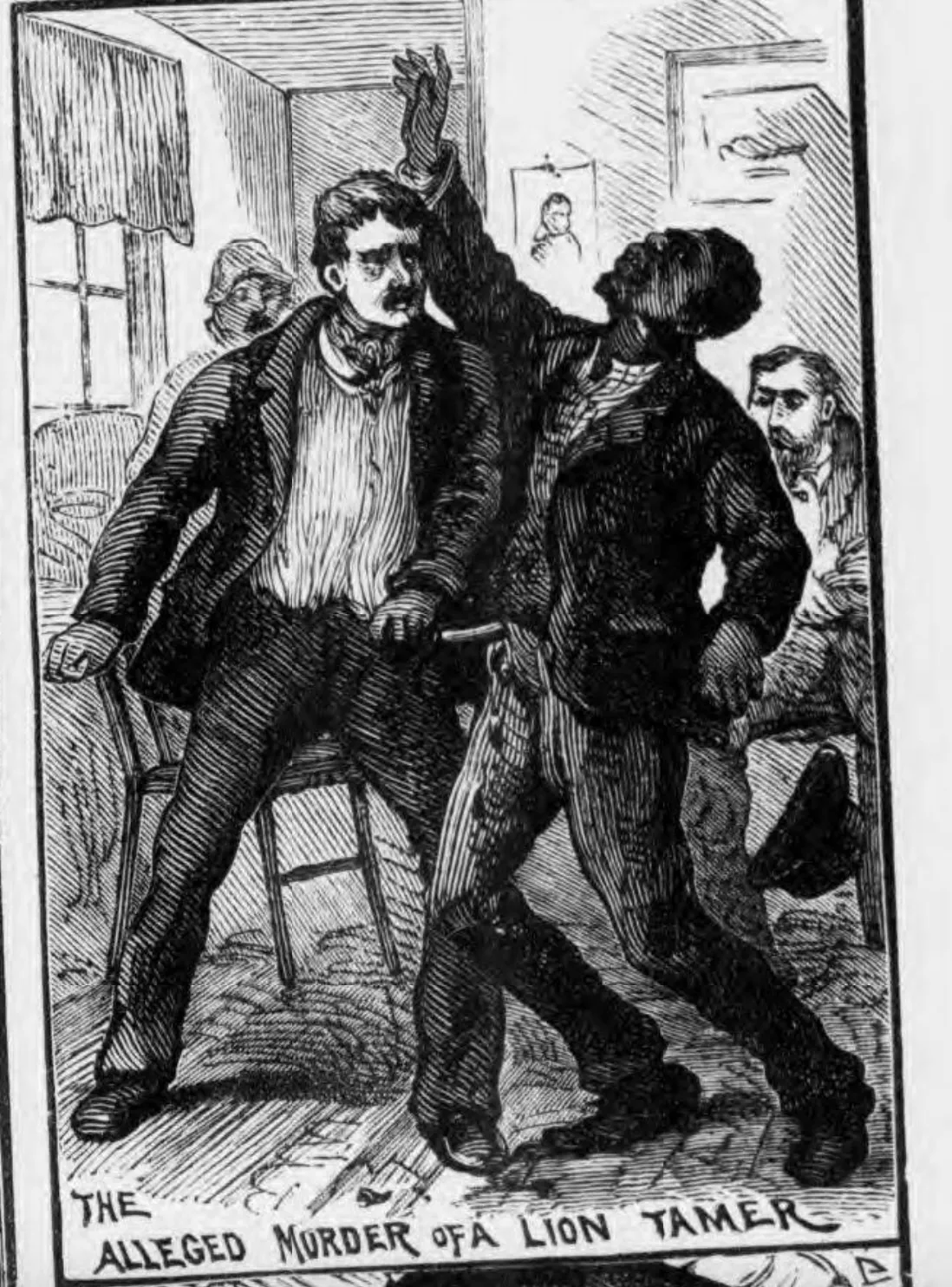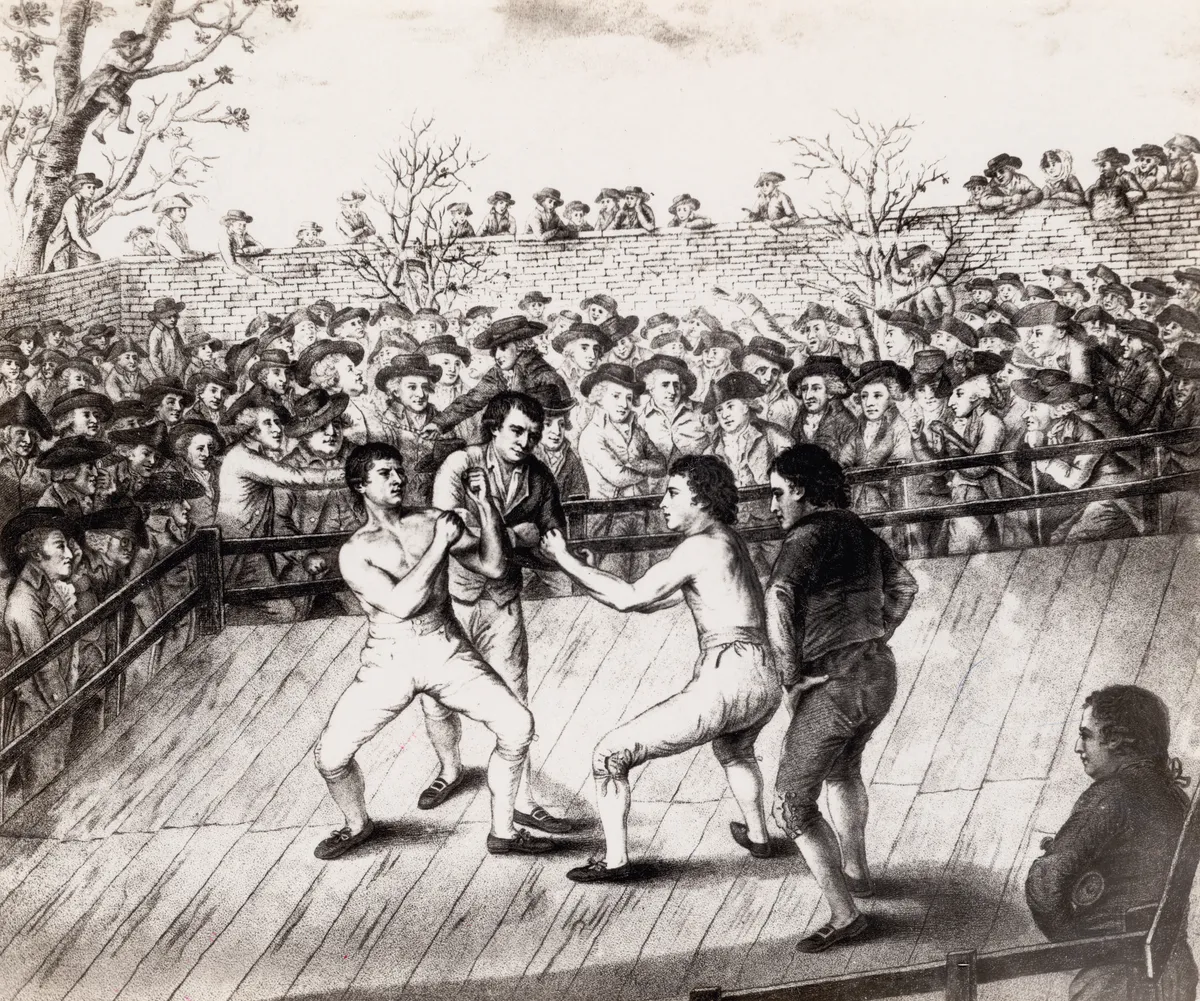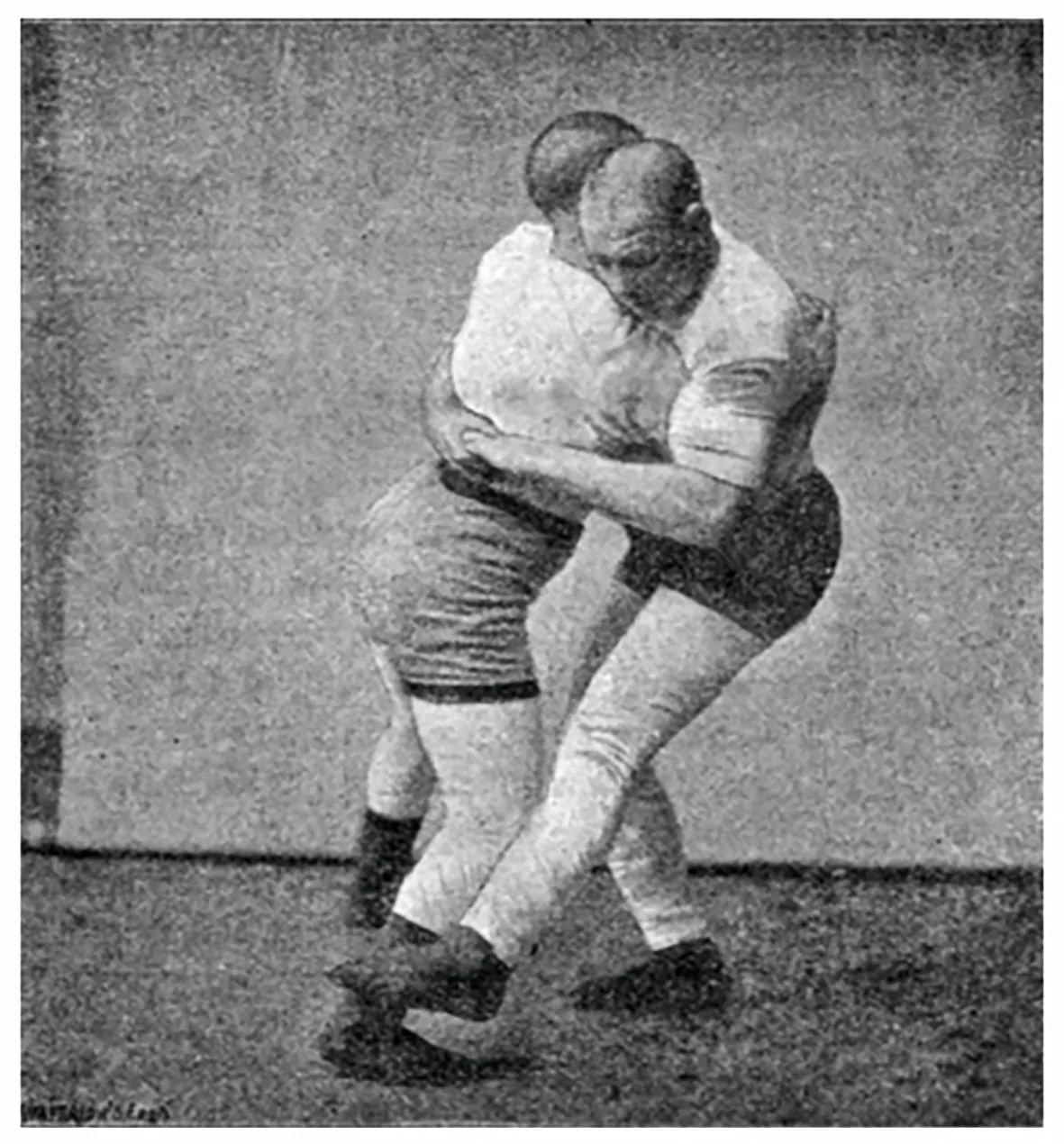On a cold February night in 1892, Jack Wannop’s cosy gymnasium in New Cross, south-east London, was packed to the rafters. Smoking, cheering, bowler-hat-wearing men filled the venue, wedged in around the boxing and wrestling rings, weightlifting area and hanging punch bags. Money exchanged hands, hip flasks were sipped, and after a couple of six-round spars and exhibition wrestling it was time for the much-anticipated main event.
Two locals, Steve and Tom, approached the ‘squared circle’, the broad-shouldered and long-limbed Steve clearly having the size advantage. Tom grinned confidently, but a hesitant Steve needed words of encouragement from his backer, Deptford greengrocer Alf ‘Nobler’ Fry. Master of ceremonies Warren ‘Dais’ Patte introduced the contestants, and the pair entered the ring at last.
A bell rang and Tom leapt forward, grasping Steve around the stomach with his left arm while hooking a leg with his right. Mustering every ounce of strength, Tom heaved Steve up and over, the pair landing with such force that they fell off the raised ring and crashed to the floor. With Steve’s shoulders touching the floor, Thomas ‘Curley’ Thompson took the win. Both got back on their feet, none the worse for the tumble, and Steve received a half-pint of beer for his troubles.
It was not the most technically impressive display of wrestling ever seen at Wannop’s ‘manor’, but the capacity crowd was satisfied with what counted for high comedy in those days. After all, Steve was a donkey.
Steve’s grappling days were over, and he did not join the Victorian kangaroos or de-toothed bears and lions forced into music halls up and down the country to satisfy a demand for ever more original entertainment.
Who were the Victorian boxers and wrestlers?
Pugilism in 19th-century London was not all fun and bad-taste animal antics. Exploring the lives of some of the most prolific and successful names in boxing and wrestling over the 1880s and 1890s – a key period of development for both sports – exposes countless stories of poverty and alcoholism, punctuated by lengthy prison sentences. There are murders, mysterious disappearances, and tragically early deaths.
Woolf Bendoff was a tough and dangerous man in the boxing ring and an even worse one out of it, serving prison terms for attempted murder, assault and handling stolen goods. John Devonport and James Haynes, alias ‘Jack Davenport’ and ‘Jem Haines’, two African-American heavyweights based in London, headlined large venues between doing time for drunkenly assaulting police officers, strangers or their female companions. Haines died at 30 from tuberculosis. Davenport cut hair, worked as a nightclub doorman, and was rumoured to have entered a mental hospital in his later years.
The respectable wrestler Walter ‘The Cross-Buttocker’ Armstrong was jailed with hard labour for cheque forgery in 1884, but by the end of the decade had published a book on wrestling and become a reporter for the Sporting Life. Tom Thompson broke both legs and was dead by 37, neither incident involving a donkey.
Hezekiah Moscow, a pugilist and bear tamer based in Whitechapel and also known as ‘Ching Hook’, had a successful boxing career in 1880–1891, toured the country as a comedy sketch artist in 1892, then disappeared on his wife and baby, never to be seen again. His friend Alexander Hayes Munroe, or ‘Alec Munro’, a mariner from Jamaica turned lion tamer turned boxer was stabbed in a boarding house in the East End in 1885, and died of infection in hospital.

The use of multiple nicknames and pseudonyms by prizefighters, many of them manual workers by day and professional boxers by night, combined with sporting newspapers’ inconsistent and racist reporting habits (often attributing white fighters to their home town or borough, but simply referring to black fighters as “black”, for example) makes a search for the men behind the ring personas a challenge. However, using old newspapers, census records, court transcripts and creative guesswork to trace individuals across careers in the ring and personal relationships builds an incredible insight into how brutal pugilism and life could be.
The story of boxing and wrestling in Britain dates back centuries, with rises and falls in popularity across decades, places, and on the backs of different people, the rare superstars proving capable of reinvigorating and reinventing their sport.
When did Victorian boxing and wrestling start?
British wrestling history is long and complex. Different regions developed different grappling styles, each with unique rules, traditions and flamboyant costumes, and when Irish, Scottish, Cumbrian, Cornish or Lancastrian men visited or settled in London, they brought their wrestling traditions with them. A hybrid style known as ‘catch-as-catch-can’ wrestling developed from the early 1870s but took a while to catch on, Jack Wannop of New Cross being among its chief proponents in the 1880s. Many wrestlers boxed too, and vice versa. From its roots in open fields and rural summer fairs, wrestling entered the pub back rooms and music halls of Victorian London, and by the early 1900s was an enormously popular entertainment, packing out theatres to audiences made up of thousands of our ancestors.
Wrestling is by its nature able to be performed in a collaboration between participants, as well as conducted competitively in an honest match. The origins of the choreographed or fixed theatrical entertainment that is so popular today lie in the exhibition matches or deliberately ‘thrown’ matches of the 19th century.
The golden age of English boxing started in around 1780 with Daniel Mendoza and Richard ‘The Gentleman Boxer’ Humphries, and was carried along by Tom Molineaux and Tom Cribb from 1810. It was both a working-class sport and a favourite of the aristocracy, and paradoxically considered quintessentially English yet dominated by immigrants.

With the introduction of an official police force in 1829 came the enforcement of laws outlawing prizefighting, and combined with a shift in attitude from the middle classes, fashionable interest had waned by the time Victoria ascended to the throne in 1837. Newspapers that had previously heralded boxing for being a masculine and heroic activity began to condemn it as morally wrong and physically dangerous. But boxing training and competition nevertheless remained immensely popular for men across social class and race.
By the 1880s, seemingly every street corner in London had a gymnasium or ‘school of arms’, most commonly on the second floor or small back parlour of a pub, or in more substantial spaces in railway arches, members’ clubs and mission halls. In the late 1880s and early 1890s the Sporting Life as well as local and regional newspapers regularly reported on the opening of gymnasiums with the physical purpose of muscular development and boxing training, and a symbolic role in the ideas of ‘muscular Christian’ nationalism, discipline and self-pride. Boxing again meant all things to all people: both art and science, it was beloved by seasoned thugs and wholesome young boys alike.
What were the Marquess of Queensberry Rules?
The publication of the Marquess of Queensberry Rules in 1867 should have put an end to the bareknuckle era. The Rules banned the use of wrestling moves in a boxing match, ensured that matches were arranged for a set number of three-minute rounds rather than a lengthy ‘fight to the finish’, and made the wearing of gloves compulsory. For many pugilists, this attempt to introduce professionalism and gentlemanly conduct was contrary to everything they loved about the sport, and fighting in the ‘old way’ continued for decades. Scattered across sporting newspapers, which reported on action and also served as notice boards for athletes to challenge each other, are references to the “old style” or fighting with “raw ’uns”. Prizefighting remained illegal, yet continued as an open secret with wealthy men backing their favourites and journalists reporting every detail.
High-profile men such as Jack Wannop and Jem Smith boasted in interviews of their preference for going barefist. Smith, a heavyweight from Shoreditch, proved particularly reluctant to give up the old ways – he lost the inaugural Commonwealth title to the black Australian Peter Jackson by disqualification in 1889 after using wrestling tactics in the ring. Smith held onto his English championship against Frank Slavin later the same year in a bareknuckle fight held in Bruges, but only after forcing Slavin against the ropes where he was attacked with knuckle-dusters by Smith’s friends. It was to be the last formally recognised bareknuckle title fight. Despite declaring that he wanted to face Ted Pritchard without gloves in 1891, ‘small’ gloves were insisted upon. Smith lost his title at Wannop’s Gymnasium to an audience of 40 after little more than 10 minutes in the ring. Pritchard died from pneumonia in 1903, aged just 35.

As the 19th century drew to a close and the 20th began, boxing became increasingly professionalised. Publications such as Famous Fights took nostalgic looks back to earlier decades, printing forensically detailed accounts and beautiful sketches of the action between the last generation of English bareknuckle scrappers. Fighters who survived past 40 turned to training, went back to labouring, or as in Bendoff’s case pursued career criminality. Many are long forgotten and buried in unmarked graves, the story of a fight for money, glory or survival waiting to emerge from the Sporting Life and knock out a new crowd.
Sarah Elizabeth Cox writes the Victorian boxing and wrestling blog Grappling With History